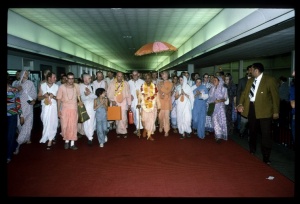CC Madhya 23.62 (1975): Difference between revisions
(Vanibot #0027: CCMirror - Mirror CC's 1996 edition to form a basis for 1975) |
(Vanibot #0020: VersionCompareLinker - added a link to the Version Compare feature) |
||
| Line 2: | Line 2: | ||
<div style="float:left">'''[[Sri Caitanya-caritamrta (1975)|Śrī Caitanya-caritāmṛta (1975)]] - [[CC Madhya (1975)|Madhya-līlā]] - [[CC Madhya 23 (1975)|Chapter 23: Life's Ultimate Goal — Love of Godhead]]'''</div> | <div style="float:left">'''[[Sri Caitanya-caritamrta (1975)|Śrī Caitanya-caritāmṛta (1975)]] - [[CC Madhya (1975)|Madhya-līlā]] - [[CC Madhya 23 (1975)|Chapter 23: Life's Ultimate Goal — Love of Godhead]]'''</div> | ||
<div style="float:right">[[File:Go-previous.png|link=CC Madhya 23.61 (1975)|Madhya-līlā 23.61]] '''[[CC Madhya 23.61 (1975)|Madhya-līlā 23.61]] - [[CC Madhya 23.63 (1975)|Madhya-līlā 23.63]]''' [[File:Go-next.png|link=CC Madhya 23.63 (1975)|Madhya-līlā 23.63]]</div> | <div style="float:right">[[File:Go-previous.png|link=CC Madhya 23.61 (1975)|Madhya-līlā 23.61]] '''[[CC Madhya 23.61 (1975)|Madhya-līlā 23.61]] - [[CC Madhya 23.63 (1975)|Madhya-līlā 23.63]]''' [[File:Go-next.png|link=CC Madhya 23.63 (1975)|Madhya-līlā 23.63]]</div> | ||
{{CompareVersions|CC|Madhya 23.62|CC 1975|CC 1996}} | |||
{{RandomImage}} | {{RandomImage}} | ||
==== TEXT 62 ==== | ==== TEXT 62 ==== | ||
<div class="verse"> | <div class="verse"> | ||
: | :'sambhoga'-'vipralambha'-bhede dvividha śṛṅgāra | ||
:sambhogera ananta aṅga, nāhi anta tāra | :sambhogera ananta aṅga, nāhi anta tāra | ||
</div> | </div> | ||
| Line 25: | Line 24: | ||
<div class="translation"> | <div class="translation"> | ||
"In conjugal love [śṛṅgāra] there are two departments-meeting and separation. On the platform of meeting, there are unlimited varieties that are beyond description. | |||
</div> | </div> | ||
| Line 32: | Line 31: | ||
<div class="purport"> | <div class="purport"> | ||
Vipralambha is described in the Ujjvala-nīlamaṇi ( | Vipralambha is described in the Ujjvala-nīlamaṇi: | ||
:yūnor ayuktayor bhāvo | |||
:yuktayor vātha yo mithaḥ | |||
:abhīṣṭāliṅganādīnām | |||
:anavāptau prakṛṣyate | |||
:sa vipralambho vijñeyaḥ | |||
:sambhogonnatikārakaḥ | |||
:na vinā vipralambhena | |||
:sambhogaḥ puṣṭim aśnute | |||
When the lover and the beloved meet, they are called yukta (connected). Previous to their meeting, they are called ayukta (not connected). Whether connected or not connected, the ecstatic emotion arising due to not being able to embrace and kiss each other as desired is called vipralambha. This vipralambha helps nourish emotions at the time of meeting. Similarly, sambhoga is thus described: | |||
: | :darśanāliṅganādīnām | ||
: | :ānukūlyān niṣevayā | ||
: | :yūnor ullāsam ārohan | ||
: | :bhāvaḥ sambhoga īryate | ||
"Meeting each other and embracing each other are aimed at bringing about the happiness of both the lover and the beloved. When this stage becomes increasingly jubilant, the resultant ecstatic emotion is called sambhoga." When awakened, sambhoga is divided into four categories: | |||
: | :(1) pūrva-rāga-anantara-after pūrva-rāga (attachment prior to meeting), sambhoga is called brief (saṅkṣipta); | ||
:(2) māna-anantara-after māna (anger based on love), sambhoga is called encroached (saṅkīrṇa); | |||
:(3) kiñcid-dūra-pravāsa-anantara-after being a little distance away for some time, sambhoga is called accomplished (sampanna); | |||
(3) kiñcid-dūra-pravāsa- | |||
:(4) sudūra-pravāsa-anantara-after being far away, sambhoga is called perfection (samṛddhimān). | |||
The meetings of the lovers that take place in dreams also have these four divisions. | The meetings of the lovers that take place in dreams also have these four divisions. | ||
</div> | </div> | ||
Latest revision as of 14:54, 27 January 2020

A.C. Bhaktivedanta Swami Prabhupada
TEXT 62
- 'sambhoga'-'vipralambha'-bhede dvividha śṛṅgāra
- sambhogera ananta aṅga, nāhi anta tāra
SYNONYMS
sambhoga—of meeting (enjoyment together); vipralambha—of separation; bhede—in two divisions; dvi-vidha śṛṅgāra—two kinds of conjugal love; sambhogera—of the stage of sambhoga, or meeting; ananta aṅga—unlimited parts; nāhi—not; anta—an end; tāra—of that.
TRANSLATION
"In conjugal love [śṛṅgāra] there are two departments-meeting and separation. On the platform of meeting, there are unlimited varieties that are beyond description.
PURPORT
Vipralambha is described in the Ujjvala-nīlamaṇi:
- yūnor ayuktayor bhāvo
- yuktayor vātha yo mithaḥ
- abhīṣṭāliṅganādīnām
- anavāptau prakṛṣyate
- sa vipralambho vijñeyaḥ
- sambhogonnatikārakaḥ
- na vinā vipralambhena
- sambhogaḥ puṣṭim aśnute
When the lover and the beloved meet, they are called yukta (connected). Previous to their meeting, they are called ayukta (not connected). Whether connected or not connected, the ecstatic emotion arising due to not being able to embrace and kiss each other as desired is called vipralambha. This vipralambha helps nourish emotions at the time of meeting. Similarly, sambhoga is thus described:
- darśanāliṅganādīnām
- ānukūlyān niṣevayā
- yūnor ullāsam ārohan
- bhāvaḥ sambhoga īryate
"Meeting each other and embracing each other are aimed at bringing about the happiness of both the lover and the beloved. When this stage becomes increasingly jubilant, the resultant ecstatic emotion is called sambhoga." When awakened, sambhoga is divided into four categories:
- (1) pūrva-rāga-anantara-after pūrva-rāga (attachment prior to meeting), sambhoga is called brief (saṅkṣipta);
- (2) māna-anantara-after māna (anger based on love), sambhoga is called encroached (saṅkīrṇa);
- (3) kiñcid-dūra-pravāsa-anantara-after being a little distance away for some time, sambhoga is called accomplished (sampanna);
- (4) sudūra-pravāsa-anantara-after being far away, sambhoga is called perfection (samṛddhimān).
The meetings of the lovers that take place in dreams also have these four divisions.